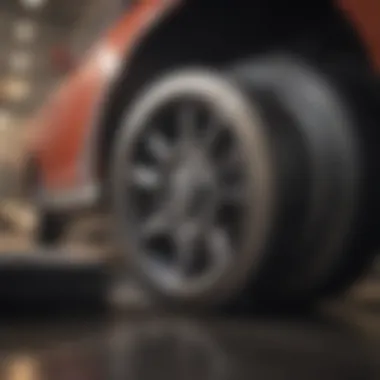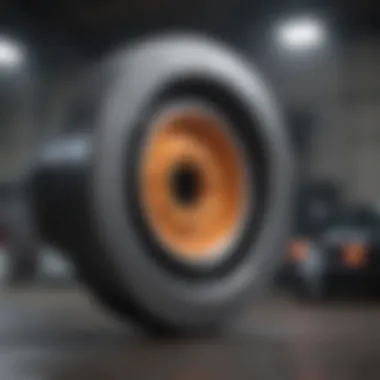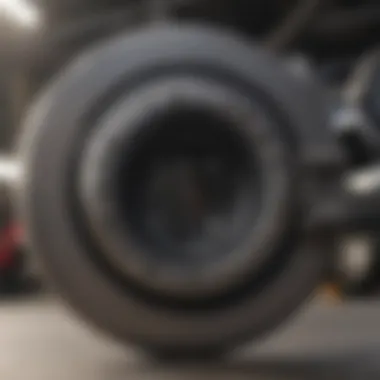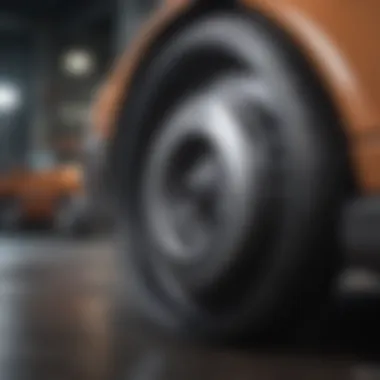Replacing Rear Brake Drums: A Comprehensive Guide


Intro
Replacing rear brake drums can seem daunting for many vehicle owners. However, understanding this procedure is crucial for maintaining vehicle safety and performance. The rear brake system plays a significant role in stopping a vehicle safely. When brake drums wear out, it can lead to reduced braking power and longer stopping distances. This article will provide a comprehensive guide to replacing rear brake drums, highlighting the process, the necessary tools, and the importance of regular brake maintenance.
It's essential to emphasize the significance of brake inspections for vehicle longevity. Regular checks can prevent larger issues in the long run. This guide aims to equip automotive enthusiasts and potential car buyers with the knowledge necessary for effective vehicle upkeep.
Tools Required
Before beginning the replacement process, ensure you have the following tools ready:
- Jack and Jack Stands - For lifting the vehicle securely.
- Lug Wrench - To remove wheel nuts.
- Brake Drum Puller - Optional for stubborn drums.
- Socket Set - For various bolts and fittings.
- Brake Cleaner - For cleaning components.
- Torque Wrench - To ensure proper tightening of nuts.
- Safety Glasses and Gloves - Essential for personal safety.
Having these tools on hand will facilitate a smoother process and minimize potential delays.
Safety Precautions
Safety should always come first when working on any vehicle. Before starting the brake drum replacement:
- Engage the Parking Brake - This prevents the vehicle from rolling.
- Ensure Stability - Use jack stands to secure the vehicle after lifting.
- Avoid Contact with Brake Dust - It may contain harmful materials. Wear a mask if necessary.
Important: Always follow safety protocols to prevent accidents while working on your vehicle.
Step-by-Step Procedure
- Lift the Vehicle: Use the jack to elevate the rear of the vehicle. Secure it with jack stands.
- Remove the Wheel: Use the lug wrench to take off the wheel. Ensure proper positioning to avoid losing any nuts.
- Inspect Components: Check other brake components like the shoes and springs for wear. This step is crucial for realizing if other parts need replacing as well.
- Remove the Brake Drum: If necessary, use a brake drum puller. Gently pull the drum away from the hub.
- Clean the Area: Use brake cleaner to remove dust and debris from the backplate.
- Install the New Drum: Place the new drum over the hub, ensuring it sits correctly.
- Reattach the Wheel: Put the wheel back on and tighten the lug nuts. Use the torque wrench to adhere to the manufacturer's specifications.
- Lower the Vehicle: Carefully lower the vehicle back to the ground and finish any final checks.
- Test the Brakes: Before driving, pump the brake pedal multiple times to ensure proper function.
Following these steps will help ensure that your brake drums are replaced correctly and safely.
Common Issues Encountered
During the replacement process, you may face several challenges. Common issues might include:
- Stuck Drums: Often due to rust or corrosion. A gentle tap or use of a puller can help.
- Worn Brake Shoes: Sometimes, the shoes need to be replaced as well. Inspect them thoroughly.
- Improper Installation: Confirm that all components are fitted securely to avoid future issues.
Awareness of these common problems can better prepare you for a successful brake drum replacement.
Importance of Regular Brake Inspections
Regular brake inspections are paramount to vehicle safety. Neglecting these checks can cause mishaps, leading to expensive repairs or accidents. It is advisable to have your brakes inspected at least every 12,000 miles or as recommended by the vehicle manufacturer. Identifying wear early allows for timely interventions and maintains optimal brake performance.
Understanding Rear Brake Drums
Understanding rear brake drums is essential for automotive enthusiasts and car owners alike. These components play a critical role in vehicle safety and braking efficiency. Knowing how they work can help maintain your vehicle and avoid costly repairs.
What Are Brake Drums?


Brake drums are circular metal components that form part of a drum brake system. They are usually located at the rear wheels of vehicles. The primary purpose of these drums is to house the brake shoes, which press against the inner surface to create friction and slow down the vehicle.
These drums are usually made of cast iron or aluminum. Because of their design, they can dissipate heat effectively, which is crucial during braking to prevent overheating and reduction in braking performance.
The Function of Rear Brake Drums
Rear brake drums serve several important functions:
- Friction Generation: When the brake pedal is pressed, hydraulic force pushes the brake shoes against the inner surface of the drum. This friction slows down the wheel and stops the vehicle.
- Heat Dissipation: The design of brake drums allows for efficient heat dispersal. This feature is vital for maintaining consistent braking performance.
- Weight Distribution: Rear drum brakes generally provide better weight distribution compared to disc brake systems, especially in larger vehicles. This characteristic aids in stability and control during braking.
A well-functioning rear brake drum is vital for overall vehicle performance.
Common Issues with Rear Brake Drums
Several problems can arise with rear brake drums. Identifying these issues early can prevent further damage and ensure safety. Common problems include:
- Warping: Excessive heat can cause the drum to warp. This condition leads to uneven braking and vibrations.
- Cracking: Over time, the stress of continual braking can lead to cracks in the drum. Cracked drums require immediate replacement.
- Rust Formation: Moisture exposure can cause surface rust on the brake drum, impacting its efficiency. Regular inspection can help mitigate rust problems.
Proper understanding of rear brake drums can significantly enhance vehicle longevity and performance.
Signs That Brake Drums Need Replacement
Recognizing when your brake drums need replacement is crucial for maintaining vehicle safety and performance. Brake drums are critical components of a vehicle's braking system. If they malfunction or wear out, it can lead to severe safety risks, including decreased stopping power. Understanding the signs of a failing brake drum can enable timely action, saving both money and potential accidents in the long run. Here are some clear indicators that suggest it might be time to replace your rear brake drums.
Unusual Noises While Braking
One of the most immediate warning signs of worn brake drums is the presence of unusual noises. Drivers might notice squealing, grinding, or a thumping sound when applying the brakes. These sounds often indicate that the brake linings are worn down, exposing metal parts. This scenario can lead to significant damage not only to the brake drum itself but also to the entire braking system. It is essential to pay attention here, as ignoring these sounds can result in costly repairs. If you hear any unfamiliar noise, it’s advisable to inspect your brakes promptly.
Vibrations or Pulsations
Another significant sign of wear is when you feel vibrations or pulsations through the brake pedal. This situation may occur due to uneven wear on the brake drum surface or issues with the brake shoes. When the surfaces of the drum and shoes are not properly aligned or worn flat, it can create inconsistency in braking. Such vibrations can affect the overall driving experience, diminishing control over the vehicle and compromising safety. If these vibrations occur consistently, it becomes crucial to seek professional diagnosis and potentially replace the affected parts.
Increased Stopping Distances
Lastly, an increase in stopping distances serves as a critical indicator that your brake drums may need replacement. If you find yourself applying the brakes and noticing that your vehicle takes longer to come to a stop, this should raise an alarm. This situation can stem from various issues, including worn brake pads or compromised brake drums. Increased stopping distances can dramatically affect safety, especially in emergency scenarios. Convincingly, if you notice any of these changes in your vehicle's braking efficiency, it's essential to consult with an automotive expert. By addressing these signs early, you can ensure a safer driving experience.
Preparation Before Replacement
Preparing to replace rear brake drums is a crucial step in the process. This preparation ensures that you have everything you need to complete the replacement safely and efficiently. Proper preparation can prevent unnecessary delays and help avoid potential mistakes during the replacement procedure. Here are the key elements to consider.
Gathering Necessary Tools
Before starting, it is important to have the correct tools ready. This will make the job easier and more efficient.
Socket Set


A socket set is essential for many automotive tasks, including replacing brake drums. It typically contains various sizes of sockets that can fit different nuts and bolts. The key characteristic of a socket set is its versatility.
Using a socket set allows you to apply more torque than a standard wrench, which is beneficial when dealing with rusted or stuck hardware. A well-organized socket set makes it straightforward to find the right size, thus reducing frustration during the process. However, a disadvantage may be the initial investment such sets require, especially for high-quality brands.
Brake Drum Puller
The brake drum puller is an important tool for removing the drum from the hub. The crucial aspect of a brake drum puller is its ability to grip the drum securely while allowing even force application. This tool is well-regarded for its effectiveness in ensuring that the drum comes off without damaging other components. The unique feature of this puller is its adjustable arms, which can accommodate different drum sizes. While beneficial, care must be taken to ensure it is used correctly to avoid damaging the brake assembly.
Lug Wrench
A lug wrench is important for loosening and tightening the wheel nuts. Having a lug wrench is a basic requirement for vehicle maintenance. The main feature of a lug wrench is its cross design, which provides additional leverage, making it easy to apply force.
This tool is generally beneficial because it allows for quick wheel removal, an essential step when accessing the brake drum. The downside is that some vehicles may require a specific size wrench that is not included in standard sets, so confirming compatibility is wise before starting the job.
Safety Precautions
Safety is a priority during any vehicle maintenance task. Taking safety precautions helps protect you from potential hazards.
Using Safety Goggles
Wearing safety goggles protects your eyes from dust and debris that may arise during the replacement process. The distinguishing feature of safety goggles is their snug fit, ensuring that nothing can enter from the sides. This protection is essential when working with brake components, which can release small particles when handled. Safety goggles are widely recommended because they prevent injuries that might otherwise occur in a workshop environment.
Working in a Well-Ventilated Area
Ensuring you work in a well-ventilated area is vital when dealing with automotive maintenance. Good ventilation helps reduce exposure to harmful fumes from brake dust and other materials. The characteristic of adequate ventilation is the constant flow of fresh air, which can help minimize health risks associated with working on vehicles. This can be particularly beneficial when working on projects that take a long time. The main disadvantage is that outdoor conditions may not always be ideal, so planning accordingly is important.
Steps to Replace Rear Brake Drums
Replacing rear brake drums is a critical procedure in vehicle maintenance. This process not only impacts braking efficiency but also affects overall vehicle safety. Understanding the steps involved ensures that vehicle owners can execute this task effectively, minimizing chances of errors and accidents. Proper replacement can extend the lifespan of brake components and improve the responsiveness of your vehicle's braking system.
Lifting the Vehicle
The first step is lifting the vehicle safely. Use a reliable jack to raise the car. It is essential to find a stable and flat surface to work on. Ensure that the jack is placed at designated lift points, usually indicated in the vehicle's manual. Once lifted, support the vehicle with jack stands. This provides extra stability and safety while working underneath the car. Never rely solely on the jack to hold the vehicle up, as it can fail unexpectedly.
Removing the Wheel
With the vehicle securely lifted, the next step is to remove the wheel. Use a lug wrench to loosen the lug nuts, turning them counterclockwise. It is advisable to loosen these nuts before lifting the vehicle since it may be easier on the tires. After loosening all the nuts, completely remove them and take off the wheel. This exposes the brake drum, allowing for further inspection and replacement.
Inspecting and Removing the Old Brake Drum
Inspecting the old brake drum is a vital step. Look for signs of wear, scoring, or cracks. If the drum is damaged, it must be replaced. To remove the drum, you may need to use a brake drum puller. This tool helps in applying even pressure, simplifying the removal process. Once the drum is loosened, pull it off carefully. Take note of how everything is arranged, as this will aid in installing the new drum. If it is stuck, a few taps with a hammer may help free it without damaging the component.
Installing the New Brake Drum
Once the old drum is removed, the new drum can be installed. Align the new drum with the brake components. Ensure it slides on smoothly without excessive force. Check for proper fitting; the drum should spin freely when installed. This is an essential check to confirm there are no obstructions or misalignment issues. Now would be a good time to inspect brake shoes and springs for wear and replace if necessary.


Reattaching the Wheel and Lowering the Vehicle
After securing the new brake drum, it is time to reattach the wheel. Place the wheel back onto the hub, ensuring that the holes align with the lug bolts. Hand-tighten the lug nuts before lowering the vehicle back to the ground. Once the vehicle is lowered, use the lug wrench to tighten the nuts in a star pattern. This ensures even pressure and secures the wheel properly. After completing these steps, your vehicle is ready for a test drive to ensure everything is working correctly.
Important Note: Always remember to follow safety precautions throughout this process.
By understanding and following these steps, you ensure that the replacement of rear brake drums is thorough and effective. Regular maintenance not only prolongs the lifespan of your vehicle's brake system but also enhances driving safety.
Post-Replacement Considerations
After replacing rear brake drums, it is crucial to follow up with careful considerations. These elements not only ensure that the repair was successful but also maintain the safety and efficiency of the vehicle moving forward. Disregarding post-replacement steps can lead to complications that may compromise both vehicle performance and driver safety.
Testing the Brakes
Once the new brake drums are installed, testing the brakes is paramount. This process ensures that all components are functioning correctly and that the installation was executed properly. Start by gently pressing the brake pedal while the vehicle is stationary. Listen for any unusual noises, which might indicate misalignment or improper installation. After the initial test, perform a short drive around the block, applying the brakes gradually.
It’s effective to pay attention to feedback from the brake pedal. If it feels too soft or spongy, there may be air in the brake lines needing to be bled out. Additionally, watch for any signs of pulsing or vibrations. These sensations often signal deeper issues, possibly linked to tire balance or other brake components.
Proper brake testing can prevent future accidents and guarantee reliable vehicle operation.
Regular Maintenance Tips
Regular maintenance is vital to avoid premature wear of brake drums and related components. A few best practices include:
- Inspection: Regularly check the brake system for signs of wear or damage, especially after extensive driving.
- Cleaning: Clean brake dust and debris from the drums to maintain optimal performance. Brake cleaner solutions can be used for effective results.
- Adjustment: If equipped with adjustable brakes, ensure they are set to the correct tension. This helps in even wear of brake shoes against the drums.
- Monitor Driving Habits: Aggressive driving can increase brake wear. Employ smooth braking techniques to prolong component life.
Maintaining a record of brake inspections and maintenance can significantly aid in tracking potential issues over time.
When to Seek Professional Help
While it is often feasible for automotive enthusiasts to replace brake drums themselves, there are situations when professional help becomes necessary. Consider seeking assistance if:
- Uncertainty Exists: If you are unsure about any steps in the replacement process or if the new drums do not fit correctly.
- Persistent Issues: If noises, vibrations, or performance problems continue despite replacing the drums.
- Brake Fluid Problems: If there are issues with brake fluid leakage or contamination.
- Systematic Brake Jobs: Cumulative issues with multiple braking components such as the master cylinder or brake lines dictate a professional evaluation.
Conclusively, while replacing brake drums is a solvable task for many car owners, understanding the importance of follow-up considerations can lead to a safer driving experience.
Closure
Understanding how to replace rear brake drums is paramount for anyone serious about vehicle maintenance. It is not just about resolving immediate issues, but also about ensuring longer-term safety and functionality. The process of replacing brake drums may seem daunting to some, but it is indeed manageable with the right preparation and knowledge.
Summary of Key Steps
- Gathering Tools and Safety Gear: Always start by assembling the right tools, such as a socket set, brake drum puller, and lug wrench. Ensure you have safety goggles on hand and work in a well-ventilated area.
- Lifting the Vehicle: Use a hydraulic jack to lift the vehicle securely, ensuring it is stable before proceeding.
- Removing the Wheel: Take off the wheel by removing the lug nuts. This provides access to the brake components.
- Inspecting and Removing the Old Brake Drum: Check for wear and tear before removing the brake drum with a puller, if necessary.
- Installing the New Brake Drum: Properly align and install the new brake drum. Make sure it fits snugly and rotates freely.
- Reattaching the Wheel: Securely reattach the wheel before lowering the vehicle and tightening the lug nuts to the manufacturer’s specifications.
Engaging in this comprehensive process not only enhances your understanding of brake systems but also fosters a proactive approach towards vehicle upkeep.
The Importance of Regular Brake Maintenance
Regular maintenance is not just a recommendation; it is essential. This is especially true for components like brake drums that endure significant wear during normal driving. Failing to regularly inspect and maintain these parts can lead to significant safety hazards.
A well-maintained brake system ensures responsiveness in critical situations, reducing stopping distances and enhancing vehicle control, especially under adverse conditions. Moreover, addressing issues early can save money in the long run. Ignoring small problems may lead to larger, costlier repairs.
In summary, the importance of replacing rear brake drums cannot be overstated. The process, while straightforward, necessitates attention to detail. Regular brake maintenance safeguards not just your vehicle's performance but also your overall safety on the road.







